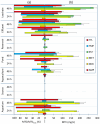Application of Microbiological Screening Tests in Assessment of Environmental Exposure to Antibiotics: Preliminary Studies
- PMID: 39311146
- PMCID: PMC11417730
- DOI: 10.3390/jox14030067
Application of Microbiological Screening Tests in Assessment of Environmental Exposure to Antibiotics: Preliminary Studies
Abstract
Contact of aquatic microbiocenoses with antibiotics present in the environment can cause the former to develop resistance to antimicrobial drugs. Therefore, the search for methods to detect antibiotics and drug-resistant microorganisms in the environment is important. The presented paper proposes a simple procedure to assess environmental exposure to antibiotics and the presence of non-susceptible microorganisms. Medium solutions with selected antibiotics and a microbial growth indicator were applied to test plates, and were inoculated with water samples from various ecosystems. After incubation, the susceptibility of the microorganisms to antibiotics was determined and presented in chronic microbial toxic concentration (MTC) values. It was confirmed that the presented procedure enables the assessment of the antibiotic susceptibility and adaptation potential of unselected microorganisms from different aquatic ecosystems. However, the MTC values depend on the inoculum volume, the density and seasonal activity of the microorganisms, the method of inoculum preparation, and the incubation time of the test plate. The described procedure may be practically applied as a screening test to identify the presence of drug-resistant microorganisms. Additionally, it may also be suitable as a method to assess environmental exposure to antibiotics. However, prior standardisation is required before implementing this procedure in quantitative studies.
Keywords: antibiotics; bioassay; environmental pollution; microbial drug resistance; microbial toxic concentration.
Conflict of interest statement
The authors declare no conflicts of interest.
Figures





Similar articles
-
[Microbiological characteristics of selected liquid soaps for hands washing].Med Dosw Mikrobiol. 2013;65(3):207-26. Med Dosw Mikrobiol. 2013. PMID: 24432560 Polish.
-
[Standard technical specifications for methacholine chloride (Methacholine) bronchial challenge test (2023)].Zhonghua Jie He He Hu Xi Za Zhi. 2024 Feb 12;47(2):101-119. doi: 10.3760/cma.j.cn112147-20231019-00247. Zhonghua Jie He He Hu Xi Za Zhi. 2024. PMID: 38309959 Chinese.
-
Ecotoxicological assessment of antibiotics: A call for improved consideration of microorganisms.Environ Int. 2015 Dec;85:189-205. doi: 10.1016/j.envint.2015.09.013. Epub 2015 Sep 25. Environ Int. 2015. PMID: 26411644 Review.
-
Highly parallelized droplet cultivation and prioritization of antibiotic producers from natural microbial communities.Elife. 2021 Mar 25;10:e64774. doi: 10.7554/eLife.64774. Elife. 2021. PMID: 33764297 Free PMC article.
-
Inoculum-Based Dosing: A Novel Concept for Combining Time with Concentration-Dependent Antibiotics to Optimize Clinical and Microbiological Outcomes in Severe Gram Negative Sepsis.Antibiotics (Basel). 2023 Oct 31;12(11):1581. doi: 10.3390/antibiotics12111581. Antibiotics (Basel). 2023. PMID: 37998783 Free PMC article. Review.
Cited by
-
Photocatalytic Degradation of Lincosamides in the Presence of Commercial Pigments: Kinetics, Intermediates, and Predicted Ecotoxicity.Int J Mol Sci. 2024 Dec 13;25(24):13370. doi: 10.3390/ijms252413370. Int J Mol Sci. 2024. PMID: 39769134 Free PMC article.
References
-
- Kemper N. Veterinary Antibiotics in the Aquatic and Terrestrial Environment. Ecol. Indic. 2008;8:1–13. doi: 10.1016/j.ecolind.2007.06.002. - DOI
Grants and funding
LinkOut - more resources
Full Text Sources

